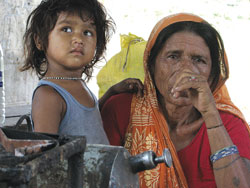|
|
These are the worst floods in living memory. And just as the waters receded and people starting going back to their homes, there was another wave of flooding early this week.
Bad weather and flooded roads hamper relief, but it is the security situation that is worrying relief officials.
"Humanitarian assistance must be delivered without obstruction," says the ICRC's Nepal head, Mary Werntz, "it should be distributed solely on the basis of need, independently of all political, communal and other considerations."
The UN\'s World Food Programme (WFP) which has pledged food for 60,000 people in the worst affected VDCs for three months says Nepal Red Cross is having problems with delivery.
"If we don\'t get safe and unhindered access, we will be unabe to provide much needed food assistance," WFP\'s Nepal director Richard Ragan said Thursday.
Santosh Jha of Tulsiyahi Jabdi VDC was marooned with his wife and three children in his house for over two weeks. His house is badly damaged, crops are washed away, and the granary destroyed.
 As the immediate emergency recedes, a food and health crisis is erupting. "There is food only for five more days, my roof is leaking, and my house is about to collapse," laments 30-year-old Jha. Children are falling sick due to contaminated water.
As the immediate emergency recedes, a food and health crisis is erupting. "There is food only for five more days, my roof is leaking, and my house is about to collapse," laments 30-year-old Jha. Children are falling sick due to contaminated water.
Nepal Red Cross workers, who are leading the relief efforts, have finally reached Jha's village. They seem to be doing their best, but in most places the relief arrived only on 8 August, nearly a month after the floods first struck the eastern tarai. "It's true, the help arrived late," admits rescue and relief coordinator, Rajan Ghimire of Caritas, "in many places it was just impossible to get to."
Eighty percent of the farms in Dhanusha and Mahottari have been washed off. Some farmers want to salvage this year's monsoon season and replant rice, but there is a scarcity of seedlings. In the medium and long-term much more needs to be done for food security and flood protection.
Relief efforts have also been hampered by the eight parties\' politicking and dysfunctional intra-agency coordination. Political parties are pressuring relief workers to list their own constituencies as 'flood affected' which entitles villagers to government compensation of up to Rs 10,000 each.
At one eight-party and inter-government agency meeting in Jaleswor, the CDO's relief efforts were at the mercy of a Department of Roads engineer who wouldn't build even one diversion.
Another engineer at the Water-borne Disaster Center told the meeting he couldn't repair the embankments without approval from Kathmandu. Armed groups in the tarai continued to threaten government staff, and civil servants use that as the excuse not to do anything.
Heavy rainfall was only one of the causes of the floods. Deforestation in the Chure silted up the river beds, making them overflow. New roads and irrigation canals that cut east-west across the plains act as dams impounding water for weeks on end.
"Riverbeds are rising every year and in many places they have risen higher than the farms on either side," says Dhanusa CDO Ram Sharan Chimoriya.
Realated Articles
. When the going gets tough...
. Mainly in the plains
. Split personality
. After the deluge
. Classroom No. 9



